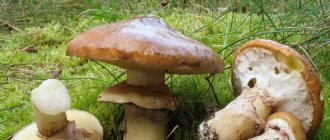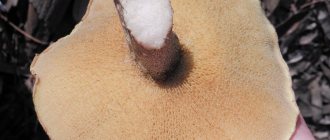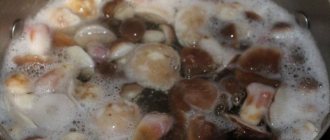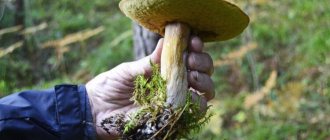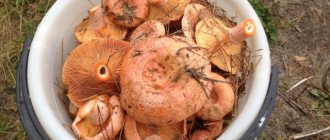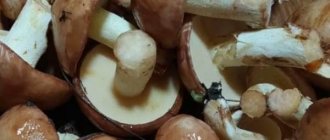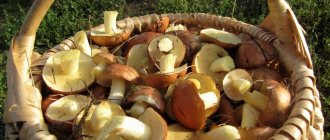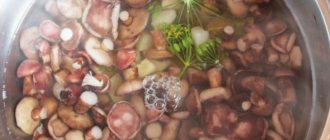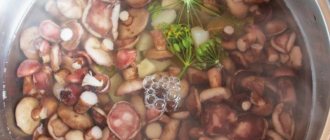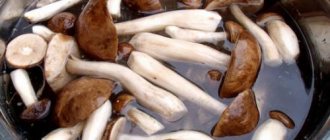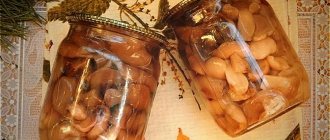Boletus is one of the healthiest and most delicious types of mushrooms, which is not inferior to either boletus or boletus.
The only difference is that the mushroom cap is covered with an oily film, so collecting the fruiting bodies can be off-putting to a novice mushroom picker. After all, in addition to the time spent getting ready, you will have to spend more than one hour to completely remove the mucus from the caps.
Do you need to clean butternuts before cooking? How to clean fresh boletus
And indeed, his hat looks like it’s been smeared with butter.
And what’s interesting is that in dry weather the cap is shiny, but if it rains or fog creeps in, it becomes slimy and slippery. So, novice mushroom pickers wonder and think: how to clean such mushrooms.
Of course, there are no specific rules. After all, mushroom pickers are a special people. And each of them has their own methods that they adhere to year after year when collecting certain mushrooms. But still there is something in common.
Collection of boletus
It is best if you start preparing for cleaning mushrooms in advance - while still in the forest.
After all, it is known how much garbage, blades of grass, soil and waste remains after cleaning mushrooms. But if part of the work is done in the fresh air, then you won’t have to pore over a bowl of mushrooms.
When cutting a mushroom, you need to immediately inspect it for the presence of worms.
If you visually do not notice anything suspicious, cut off the lower part of the leg to get rid of adhering soil.
Using a special brush or knife, remove at least the bulk of the adhering debris from the cap: leaves, blades of grass, pine needles.
The peculiarity of butter mushrooms is that when cleaning mushrooms, the skin is removed from the cap. True, not for everyone, but only for large specimens. Since this skin gives the finished mushrooms a bitter taste. And the appearance of the mushrooms with dark rags on the cap leaves much to be desired.
But the skins of small butterfish are not removed. And no one complained about the bitter taste of such mushrooms. Apparently, the skin begins to taste bitter much later.
Although some gourmets believe that it is the bitterness that gives the butter butter its piquancy. But as they say, there is no arguing about tastes.
Some mushroom pickers, while still in the forest, begin to remove the skin from the butterdish cap. This, of course, greatly simplifies the process of cleaning mushrooms at home. But there is such a nuance: peeled mushrooms need to be processed as soon as possible. And if the mushroom picker assumes that he will wander among the trees for a long time in search of mushrooms, then it is better to remove the skin from the butter at home.
The exception is when mushrooms are prepared for drying. After all, such mushrooms cannot be washed or even wet. Since wet mushrooms dry poorly and can become moldy.
Some people find it difficult to remove the skin. But in fact, it is much easier to remove from recently picked mushrooms than from those that have been lying in the basket for several hours.
Moreover, this process is also affected by the weather. Immediately after rain or in cloudy weather, the skin of the butter dish is removed much easier than in dry weather. Although during drought it is generally very difficult to find mushrooms. And if they are found, then, as a rule, they are wormy...
How to clean boletus at home
It is not customary to soak boletus in water, as is done with many other mushrooms.
The fact is that boletus, like a sponge, quickly absorbs water. Of course, almost all the adhering debris will be removed from them. But if you decide to fry the mushrooms later, they will float for a long time in the liquid released from them, which will not make them tastier.
Method 1. Mushroom pickers who know a lot about this matter do this: lightly moisten the cap of a large butter dish with water, and then use a knife to pick up the skin from the edge of the cap and, holding it between the knife and your finger, pull it through the center of the cap to the other edge. The skin gives in easily, like the skin of a potato boiled in its jacket.
If the top of the oiler’s cap is very dry, for example, from long-term storage after collection, then it can be soaked for just a few minutes in cold water and then dried in air. Since it is impossible to hold a wet oil can in your hands, and it always tries to slip out.
But many mushroom pickers do not risk moistening the boletus with water, since after such manipulation you need to have incredible virtuosity in order to pick up the skin on the cap without dropping the mushroom. Therefore, most often these mushrooms are cleaned dry, without the risk of contact with water. And they clean very successfully.
There is another way to peel butternuts.
Method 2. To do this, place a portion of butter in a colander, place it on a pan of boiling water and keep it over steam for about half a minute. It is easy to remove the skin from oils treated in this way.
Some books on mushroom picking describe this method of cleaning boletus.
Method 3. Place the butter in a colander and immerse it in boiling water for five minutes. Then they are dipped several times directly in a colander into cold water. Such boletus easily separates from the skin on the cap.
In peeled butternuts, the cap is separated from the stem. Large caps are cut into several parts, simultaneously carefully looking for parasites in the pulp of the mushroom. Because worms love to feast on these mushrooms. Some mushroom pickers also remove the spongy layer under the cap. But then there will be nothing to eat, since only one leg will remain.
Now the boletus is ready for further processing.
What to do with clean material
And now the dirty work is behind you, clean little white heads lie on the table in front of you. Then everything depends on your culinary imagination.
If you plan to boil and marinate, you can separate the cap from the stalk and cut the top into several parts. This is true for large-sized specimens.
These steps will help identify wormy areas and simply trim them off.
For frying, you can cut the butternuts into strips; halves are suitable for soup.
For freezing, the shape does not matter.
The simplest way to clean butter
Every experienced mushroom picker knows that the skin of a mushroom cap can be easily and quickly removed in two situations: immediately after cutting or as a result of slight drying. How then to properly clean boletus, taking into account this feature? It turns out that it is recommended to carry out the cleaning process while still in the forest, immediately after cutting. To do this, you need to carefully grab the edge of the film with a knife and pull it towards you, and cut off or scrape off the rest of the dirt. But this method is beneficial only in sunny weather, as well as with a small harvest.
We invite you to watch a visual video showing how to clean boletus right in the forest:
However, not all lovers of “quiet hunting” can afford to clean the crop immediately after harvesting, especially in cloudy and humid weather. After all, then the fruiting bodies also gain moisture. How to clean wet boletus in this case? It's very simple: when you come home, just lay them out on a cloth or newspaper right on the floor in the room. Wait a couple of hours and you can safely begin processing. And if the weather permits, you can put the boletus right in the yard in the sun or in a well-ventilated shade. After an hour and a half, the dry skin can be removed with a knife without any problems.
Cleaning using vegetable oil
As already mentioned, the main problem when cleaning butter is the film that constantly sticks to the skin of the hands and the knife. Therefore, as it turns out, regular sunflower oil will help clean the boletus. Lubricate the knife and hands well with it, and then start cleaning. Repeat the procedure of lubricating the knife from time to time. It must be said that with this option, the skin of your hands will not darken, and the film will easily be removed from the mushroom and will not stick anywhere. Then use a knife to remove dirt in the area of the leg and cut off its tip.
Cleaning with a dry sponge
Is it possible to quickly peel boletus without a knife and how to do it? In this case, use a regular kitchen sponge. Just take each mushroom and rub it gently. This method is also effective for young specimens. In principle, you can clean small boletus, as is the case with their more mature representatives, using all the methods mentioned. But as already mentioned, it is absolutely not necessary to remove the skin from the caps of young mushrooms.
Cleaning with boiling water
The following method is also considered popular and in demand. How to quickly clean boletus using boiling water? To do this, place a portion of fruiting bodies in a colander and hold over a pan of boiling water for about 30 seconds. You can put the butter directly in a colander in boiling water for 2-3 minutes, and then dip it in cold water several times. Thanks to this method, the mushroom cap will easily part with the sticky film.
You can also watch video recommendations on how to quickly clean boletus using boiling water:
Cleaning with salt
This method applies to removing remaining dirt after basic cleaning. The fact is that salt perfectly opens the pores of the mushroom, as a result of which even the smallest impurities are removed. So, how to clean boletus with salt and prepare the product for further processing? Simply place the peeled mushrooms in a bowl of salted water (at the rate of 150 g of salt per 1 liter of water) for 15-20 minutes, then rinse thoroughly under running water. It must be said that this method is also effective for wormy fruiting bodies. In a salty solution, worms float to the surface, and insect eggs settle to the bottom.
Popular articles Fragrant geranium: medicinal properties, features of cultivation and careCleaning with gauze
We would also like to share with you a very original way of cleaning butter. Some housewives successfully use ordinary gauze soaked in vinegar or sunflower oil in their kitchen arsenal. Take a piece of gauze, fold it in several layers, press it tightly to the cap of the oil can and pull - the film will be removed without any effort.
Other methods and recommendations
There are several other tricks on how to clean the oiler cap. Everyone has the necessary tools for this at hand. For example, a non-standard cleaning method using gauze cloth.
What is needed for this:
- a piece of gauze;
- well sharpened knife.
Before cleaning small mushrooms, you must first remove the sand from the cap. The next step is to fold the gauze into 3-4 layers and apply it to the hat, then pick up the edge of the film with a knife and tear it off by sharply pulling the gauze.
For large mushrooms there is an easier way - break them in half. The butterdish should be cut in half vertically, up to the cap. Then carefully separate the halves in opposite directions and remove the sticky peel.
On a note! If you put the butter in a colander and put it in boiling water with vinegar for 30 seconds, the film will come off easily and without much effort.
There is another quick way that allows you to clean the oiler cap. You will need a clean dish sponge and vinegar.
Detailed instructions:
- To prepare the solution, mix 2 teaspoons of vinegar in 0.5 liters of water.
- Moisten a dry sponge in the solution and then lightly rub the surface of the cap.
- After removing the top layer, the fruiting bodies must be rinsed and dried with a cloth.
Preparing oil for cleaning and precautions for hands
Before cleaning, you need to determine the subsequent cooking method. For drying, for example, it is not necessary to remove the oily film. It will be sufficient to remove debris from the cap and fruiting body with a hard brush.
If subsequent heat treatment of the product is planned, the product is completely cleared of sticky film. Before removing it, the mushrooms must be thoroughly washed in water several times to completely remove sand and debris from the surface of the product.
It is advisable to rinse the mushrooms and begin cleaning them as soon as possible after harvesting. Collected boletus can be stored in the refrigerator for up to 12 hours without packaging. If you package them up and put them in the refrigerator, they will be uncookable once they warm up from the cold.
Advice!
Before you start processing, you need to prepare two types of gloves: rubber for washing and cleaning, cellophane for subsequent preparation. This measure will help avoid the need to remove stains from your hands and blackness under your nails. When collecting butter, it is also advisable to use gloves, a plastic bag or a cloth.
Answers to frequently asked questions
How to get rid of black spots on hands?
If during the treatment process oil juice still gets on the skin of your hands, you can prepare a bath of citric acid. To do this, prepare half a liter of warm water and 25 g of citric acid. Hands should be kept in this solution for no longer than 5 minutes, and after completing the procedure, wash them with soap and spread with a rich nourishing cream. If the stains are not very bright, you can use soda or laundry soap. More effective, but not recommended, methods are cleaning your hands with acetone or fuel oil removal gel.
Do you need to soak the butter before cleaning?
There is no need to soak the butter before cleaning. Otherwise, the mushrooms will absorb a lot of moisture, and the oily skin will become even more slippery.
Is sticky mushroom juice dangerous?
The whitish aromatic juice that is secreted through the hymenophore is not dangerous. Its smell often attracts many insects, which is why boletus sometimes cannot be collected in perfect condition.
What happens if you don’t remove the film from the cap?
If you do not remove the film from the boletus cap, the dish prepared from them will have a bitter aftertaste. This is especially true for old fruits. Some gourmets, on the contrary, prefer food with bitterness, so the question of the need to clean such mushrooms is a matter of taste. However, it is recommended to remove the film to avoid digestive upset. Young boletus does not need such treatment at all: their film is very difficult to remove, and it does not impart bitterness to the food.
Butter is a product that, when processed correctly and in a timely manner, has very high taste qualities. After preparation, they can be used in cooking in fried, dried and pickled form.
Butterflies are popular and healthy edible mushrooms, whose appearance justifies their name. An oily film is noticeable on the cap, which is needed to protect the fruiting body from drying out. Debris, pine needles, and foliage easily cling to such a film, which is why cleaning oils often causes difficulties. There are several ways to clean boletus mushrooms, which speed up the processing and cooking of collected mushrooms.
Forest squid
How to clean boletus correctly.
Anyone who has ever cleaned boletus with their hands knows well what their hands look like after this procedure - they are covered with dark and brown stubborn stains, as if they were stained with fuel oil. At the same time, an attempt to wash your hands with soap ends in a complete fiasco - the paint will fade a little, but will not go anywhere. Like a sea squid, the oiler splatters ink on everyone who tries to deal with it.
All this happens because the mucus covering the mushroom cap contains a lot of iron. When the mucus on your hands mixes with the mushroom juice, it creates a chemical oxidation reaction on the skin. That's why these stains are so difficult to wash off - it's not dirt, the paint is firmly etched into the skin. If you don’t take protective measures in advance, or then don’t scrub off the stains using a special technology, you can then walk around with your hands like a stoker’s for several days.
Do I need to soak the oil before cleaning?
Note! When kept in water for a long time, mushrooms absorb moisture and become slimy, which can complicate the cleaning process, fray your nerves, and even lead to minor injuries. If soaked for a long time, this type of mushroom may become unusable.
So it’s worth remembering: the butter does not need to be soaked before cleaning. If this is still required to remove worms or other contaminants from the mushroom body, then they must be dried in a colander or laid out on a towel.
If soaked for a long time, this type of mushroom can become unusable. So it’s worth remembering: the butter does not need to be soaked before cleaning. If this is still required to remove worms or other contaminants from the mushroom body, then they must be dried in a colander or laid out on a towel.
It is best to soak in a salt solution for literally two to three minutes. Also, you should absolutely not soak the fruits before drying; just cleaning them from pine needles, leaves, grass - anything that could stick in the forest is enough.
Impostors
Not all boletus belongs to the edible group. Among them there are false, inedible and poisonous specimens. There are three ways to distinguish “copycats” from the original:
- by color - natural mushrooms are bright yellow or purple, while false mushrooms are gray-brown;
- by smell - the sticky coating on the cap of the butter dish should not smell bad (for example, vinegar or fish), a strong smell is a sign that the mushroom is unsuitable;
- to the touch - the flesh of fake butternuts is more watery and bends easily.
How to clean boletus
Based on the above arguments, we can come to the conclusion that it is still necessary to clean them. But taking into account their natural characteristics, another question arises: how to quickly clean boletus? After all, due to the stickiness, the cleaning process takes more than one hour, especially if there are a lot of mushrooms. And here there are some tricks that will help simplify this task.
The first and most important rule for cleaning oils: they must be dry. Wet mushrooms immediately “loose” and become doubly sticky, which is why the peeled skin immediately begins to stick to your hands, the knife, and back to the mushroom. From here we can derive some basic tips on how and when it is best to clean the collected boletus.
Cleaning methods
- In dry, sunny weather, it is better to clean boletus directly in the forest. This will greatly simplify the task, and will also eliminate the need to wash an accidentally dirty kitchen. To clean, just pry the skin on the edge of the cap with a knife and pull it towards the center or towards you. When the mushroom is fresh and relatively dry, the sticky skin will come off without much difficulty. Large boletus mushrooms can be cleaned even easier: the mushroom is cut in half from the stem side, not reaching the sticky skin, after which the halves are carefully stretched to the sides, and the skin is picked up and separated from the cap.
- If it has recently rained, it will not be possible to clean the boletus found on the spot. But this can be done at home after pre-drying. To do this, just bring the mushrooms home and spread them out on newspapers or cloth. It’s even better if there is air circulation in this place in the form of a slight breeze and sunlight, then the mushrooms will dry out even faster. After this, they can be cleaned in any convenient way.
- The most popular way to quickly clean boletus involves using boiling water. To do this, you need to boil a large volume of water (at least 2-3 liters), and then place the mushrooms in a saucepan for 30 seconds. The extracted boletus should be peeled very easily: the skin is no more difficult to remove from them than from potatoes. If for some reason scalding mushrooms is not suitable, you can use a double boiler. If you steam them for the same half a minute, the effect will be the same as after boiling.
- Cleaning is done with vegetable oil. As you know, the main difficulty when removing the skin is that it starts to stick to everything. This problem can be easily minimized: just lubricate the knife and hands you use with vegetable oil.
- You can also clean boletus with gauze. To do this, you need to tightly press a piece of gauze to the mushroom cap, give it a few seconds to stick, then, picking up the edge of the skin, pull it and the gauze away.
- You can also clean mushrooms with a dry sponge. To do this, just gently but thoroughly rub the mushroom cap with it.
It is also worth noting that if the mushrooms are intended for drying, it is not necessary to peel them. It is enough just to remove stuck leaves and other forest debris, as well as clean off or cut off stains of dirt.
Is it necessary and how to clean small butterflies?
To know for sure whether it is necessary to peel small mushrooms or not, you should decide where exactly you will decide to use them and what dish to add them to. Small butter beans are easier and faster to clean than large representatives, since they have a dense film.
Popular articles How to make a standard tree from thuja
If you are making soup from butter, then thoroughly clean the mushrooms first. This is because when they come into contact with liquid, the oiler of the cap begins to swell, as a result of which the water becomes viscous and sticky, like jelly. In this case, you are unlikely to want to eat such soup, and you won’t be able to scoop it into a spoon.
To avoid peeling mushrooms, you need to soak them in cold water.
Many people, if they want to fry small butterfish or stew them, do not clean the film, because they consider this process to be very labor-intensive. If you don't want to peel the mushrooms either, just wash them thoroughly under cool water. If you decide to peel small boletus, place them in boiling water for a few seconds. Over a given period of time, dirt and grass residues will fall away, becoming clean and beautiful.
Do I need to clean the butterflies?
Many mushrooms are soaked to remove bitterness. But this does not apply to the oiler. Mushroom juice is not bitter, long soaking worsens the taste.
The film must be removed from the cap, since when preparing first courses, the oily skin swells and absorbs moisture. The mushroom develops mucus and the entire mushroom broth becomes viscous. Not only the appearance of the soup is lost, but also its taste, because the film is bitter. You can get intestinal upset if you eat a lot of unrefined butter. Without film, the dish turns out soft and tender.
To marinate, you just need to remove debris from the surface of the cap and wash the mushrooms. Usually only large specimens are peeled. Boil twice, drain the first water. Bitterness and mucus go away along with it. After the second boiling, add salt, vinegar, spices, the solution is no longer very viscous. This does not affect the taste of the product.
If the mushrooms were collected within the city, then the mushroom fruits absorbed all the environmental pollution. Picking mushrooms in the city and eating them is dangerous to health.
Rules for processing oil after harvest
Before you learn how to process boletus after harvest, you need to familiarize yourself with several important rules. Firstly, every mushroom in the forest must be cut off with a sharp knife, because by pulling it out with our hands, we risk damaging the mycelium. This will lead to the fact that next year you simply will not find a single mushroom in this place. Secondly, after cutting off the wormy fruiting body, do not throw it away, but place it on the nearest branch with the cap down. You will be surprised next time you come to this place:
a new harvest will await you. Thirdly, collect boletus only in proven places - away from the roadway and industrial enterprises. This will protect you from poisoning, because these mushrooms absorb harmful chemical compounds from the air well.
So, how to process boletus mushrooms after harvesting? It’s interesting, but experienced mushroom pickers advise starting this process in the forest. There is always a lot of dirt and debris on the oily caps of these fruiting bodies. And if you carefully clean this film with a knife while still in the forest, you will greatly simplify your task when you come home.
However, if for some reason you were unable to start processing oilseed in the forest, then when you return home, do not delay this process. In this case, where should we start processing oilseeds after harvesting? The first thing to do is spread a newspaper or cloth on the floor. Pour the entire harvested crop on top and sort it by size. Then you can begin the labor-intensive process of cleaning the thin, slippery film that gets very dirty on your hands. It must be said that it is recommended to use rubber gloves for this process, which will help you keep your hands as clean as possible.
The initial processing of boletus after collection should be dry - they cannot be soaked in water, unlike other mushrooms. You can take a dry sponge and thoroughly wipe each mushroom cap. But it’s better to do this with a knife: scrape off all visible dirt, remove the oily film, cut out the rotten places and remove the remains of the mycelium from the stem. Only then can the mushrooms be placed in water for 20 minutes to remove any remaining dirt. A very effective way to rid boletus of adhering debris is to treat it with boiling water. Place the peeled fruiting bodies in a deep container, pour over hot water and leave for a few minutes.
The next stage of processing will be slicing the boletus mushrooms. Small specimens can be left whole, while large ones can be cut into pieces. Finally, the mushrooms must be boiled in water with the addition of salt and citric acid. This process is mandatory and should last an average of 25 minutes.
But no matter how carefully you collect the forest harvest, you will still come across mushrooms with worms. What to do with wormy boletus after harvest? There is no need to throw them away:
clean and place in salt water for 3 hours. Then the worms will float to the top, and the larvae will sink to the bottom. Then simply rinse the mushrooms with tap water and use them as you wish. I must say that such mushrooms are perfect for freezing.
How to quickly clean boletus and quickly clean your hands afterwards
The adhesive film on mushroom caps not only protects them from various natural unfavorable factors, but also stains the hands of the person who cleans them due to the pigment contained in the mucus. Therefore, the science of how to properly clean boletus will be incomplete without a short course on safety precautions for women’s hands.
If fungal mucus stains your hands, you need to use vinegar, citric acid or pumice to clean the skin. A cloth is moistened in vinegar or citric acid solution and wiped thoroughly.
Another way to clean your hands after cleaning butter is to take a handful of coarse table salt and make movements as when washing your hands. Pumice stone is used to treat contaminated skin, but without fanaticism! Still, this product is not intended for gentle female hands.
After any cleaning, apply moisturizer to your hands. Optimally - for children.
All of the above methods have disadvantages, the main one of which is that in the presence of microtraumas, all this is painful, since the substances penetrate through scratches and other damage and irritate the nerve endings. And when picking mushrooms, it’s difficult to do without scratches. Therefore, it won’t hurt to get gloves that will eliminate darkening during mushroom processing.
Delicious buttered mushroom
How to properly clean butter mushrooms
The wonderful butter mushroom is famous for its sticky buttery cap and wonderful, satisfying taste. It is very popular among Russian mushroom pickers and is suitable for preparing many delicious dishes and storing for future use.
If luck smiles during a quiet hunt, then a happy mushroom picker can return home, loaded to the brim with fresh boletus.
Now you need to quickly clean and cook these delicious mushrooms, and butter mushrooms have their own tricky features, like the ability to incredibly dirty your hands when cleaning, or the need to remove the sticky skin from the mushroom caps. This article describes how to process boletus at home correctly and without problems in order to enjoy their wonderful spicy taste as soon as possible.
Why do you need to remove the skin from the caps of butterfish?
Butterflies are universal mushrooms, since they can be used to prepare any dish with the addition of vegetables, meat, cheese, eggs, as well as make any preparation for the winter: fry, stew, etc.
However, having brought boletus from the forest, you need to know how to process it correctly. The process itself is labor-intensive, especially due to the slippery skin of the mushroom. In this case, the question arises: why clean the oil from the film at all?
To understand why you need to clean the caps of boletus mushrooms, you need to familiarize yourself with the structural features of these mushrooms. Each type of mushroom has its own structure, taste and benefits. Butternuts are beautiful fruiting bodies rich in vitamins and amino acids. They can improve digestion, relieve headaches, and their enzymes even help in restoring the body after acute respiratory viral infections and acute respiratory infections. But the mucous film on mushroom caps collects debris, accumulates toxic substances and radiation. Therefore, removing the top layer of the oil can cap is mandatory, despite the fact that this process causes a lot of trouble during initial processing. In this material you will learn useful recommendations on why you need to clean the caps of butterflies, and how to do it.
Oils can be soaked in water to remove most of the dirt. Then why remove the film from the oils if you can just wash them well? Note that soaking is allowed only after removing the oily skin from the mushroom cap. Staying in water for a long time has a bad effect on unrefined boletus; they quickly absorb liquid, becoming watery. Then processing these mushrooms will seem like “a real hell” to you. Wet boletus is very difficult to pick up and hold in order to clean it. They become so slippery that you need to become a virtuoso to remove the film from them.
Popular articles Meet Fermer.Blog on YouTube!
Features of the type and benefits
Even though there are many types of butterfish, they are all very similar to each other. The smooth stem is cylindrical in shape, the flesh can be light yellow or white-gray. If you cut or break the latter, it may turn blue or red.
The cap of young organisms has the shape of a hemisphere, but becomes flatter with age. Both the cap and the stem are eaten. The sign by which the oiler can be distinguished is a tubular-shaped hymenophore. The tubes located on the back of the cap help distinguish boletus from poisonous fruiting bodies.
Large accumulations of these fungi are most often found in coniferous forests. They grow, as a rule, in open areas, well lit by the sun, on moss, old pine needles and sandy soil. They are not found in open ground areas where there is no grass or bushes. Collection time is May-October.
Butter is often used in cooking due to its high nutritional qualities, high content of nutrients, fiber and amino acids. The body absorbs the latter by 80%. Young organisms are richer in amino acids than old ones. Butter is also rich in potassium salt, iron and phosphorus, and contains vitamins such as A, B and B1, PP, C. The beneficial effect on the human body is manifested in the prevention of headaches and the treatment of gout.
Chicken salad
Champignons are more common in mushroom dishes: they are easier to prepare and are available all year round. Recipes with boletus are less common, which does not detract from their taste and benefits. Due to their small size, they can not be divided into parts, but used as a whole. One of the hearty and tasty dishes is salad with butter and chicken. The balanced composition of mushrooms harmonizes well with protein-rich chicken meat.
Ingredients:
- canned boletus – 200 g;
- chicken breast fillet – 400 g;
- egg – 4 pcs.;
- onion – 1 pc.;
- mayonnaise – 100 g;
- Boil a whole chicken breast fillet in lightly salted water.
- Chop the onion as finely as possible.
- Boiled eggs should be cut into medium pieces.
- The mushroom mass must be separated from the marinade by straining using a colander. If the mushrooms are small, then cutting them additionally is not necessary.
- Cut the chicken breast into pieces or remove the fibers by hand. Place on the bottom of a salad bowl. Lubricate with mayonnaise.
- Next comes the onion-mushroom layer. Finally, add the eggs and coat with mayonnaise. If desired, this sequence of layers can be repeated twice.
A special procedure is to remove the sticky skin from the cap
How to properly clean boletus
Why remove the leathery film from boletus, and is it necessary to do it at all?
- The skin can give a mushroom dish a bitter taste.
- When cooked, the skin often becomes too tough.
- In a marinade or brine, the skin makes the surface of the mushroom “snotty,” which is not dangerous, but not to everyone’s taste. When preparing soup, butternuts with the skin still on also make the soup cloudy and viscous - eating such soup is not very pleasant.
- Also, when canning, the skin turns the brine a dark color.
- Peeled fruit bodies look much more appetizing.
The skin is difficult to remove from the smallest, youngest butter mushrooms, so you can leave it on these specimens, but only if you are going to fry these mushrooms. If you plan to cook soup from them, or marinate mushrooms, it is better to sweat and still remove the skin.
Do I need to clean the butterflies?
Butterflies are found everywhere in the temperate and northern climate zones; they are a traditional forest species and belong to the edible form. However, most all kinds of recipes still recommend peeling mushrooms from their outer coverings.
And there are several reasons for this:
- during growth, the skin accumulates dust particles containing heavy metals and other toxic pollutants on its surface;
- the unpleasant mucus of the mushroom can be completely removed only by removing the peel;
- only after cleaning can you be 100% sure that there are no false oils in the basket;
- unpeeled mushrooms can taste bitter, especially large specimens;
- the peel gives the brine a dark color during preservation;
- peeled fruit bodies in dishes look more aesthetically pleasing;
- Removing the top covers allows you to completely eliminate the remains of soil, forest litter, etc.
Small boletus
Young boletus often does not exceed 1–2 cm in diameter, so the question of whether they need to be cleaned is quite relevant. Sometimes this process can take several hours, which is not always advisable. To decide whether to peel mushrooms or not, you should ask yourself about the ultimate purpose of using the product.
If a small mushroom will be used for preparing soups and other first courses, cleaning must be done. Without this process, the mucus from the peel will give the broth a grayish-brown tint, and can also lead to a slippery, jelly-like state. This almost always leads the dish to be aesthetically unsuitable, since not everyone will eat soup with an uncharacteristic consistency and cloudiness.
You can not remove the film from the cap and stem of a small mushroom only if in the future it will be used for stewed and canned dishes, as well as frying. At the same time, you must remember that the final dish can be painted in all sorts of brown shades. This will not change the taste characteristics of the mushroom and other ingredients, but will undoubtedly affect its aesthetics.
Important! It is strongly not recommended to soak boletus before cleaning. This will lead to oversaturation of the pulp with moisture, which during heat treatment will turn it into a homogeneous thick mass.
Is sticky mushroom juice dangerous?
Milky sap is a white liquid that flows out when the fruiting body is wounded. In some cases, this may mean that the mushroom that was cut is poisonous. But, there are many edible varieties that secrete this very milky juice. The list includes: milk mushrooms, camphor milkweed, saffron milk cap, milkweed, pink trumpet. All mushrooms require soaking, otherwise they are completely unusable.
The milky juice makes the mushrooms bitter and not at all beneficial for the human body. First of all, before you start cooking, you should make sure that the chanterelle or butter dish that is to be cooked is not false. You should also be careful with mushrooms containing milky juice; most of them are conditionally edible and should not be eaten without special preparation.
“Vodka” salad with mushrooms and pickles. We recommend trying the “Vodka” salad even for those who do not drink strong drinks at all. Dish…
In order to prepare a mushroom with this “seasoning”, you need to thoroughly clean it, remove the top layer from the cap, clean the inside, under the cap, cut off all excess and rinse the resulting material, take a pan, fill it with cold water. Leave the peeled fruits for several days, constantly changing the water, the more often the better. You can add salt and a little citric acid, but this is not necessary. And only after this procedure begin cooking. The only exception is saffron milk caps - their juice is not bitter at all and they do not require soaking.
Using these simple rules and tricks, you can greatly simplify your work. Having cleaned the boletus quickly, you will soon be able to try dishes prepared from them.
How to quickly peel the skins of boletus using vinegar
Butterflies are tasty and healthy mushrooms. The basket can be filled in a short period of time, as they often grow in families. But when you come home with a large basket, you can spend a lot of time cleaning. There are many different ways to quickly remove the mucous membrane from the cap. One of them is the use of table vinegar:
- Bring 1 liter of water to a boil, add 4 tbsp. l. vinegar. Next, drop the mushrooms in portions into boiling vinegar water for 20 seconds. Treated specimens are cleaned of dirt and mucous skin. Thanks to vinegar, the dirt will come off and the mucous membrane will be easily removed.
- A household sponge is moistened with a weak vinegar solution and the cap is thoroughly wiped. This method easily removes mucus and film from the surface. After removing the oil shell, the mushroom collection is immersed in water for 10 minutes to remove sand and dirt. You can add a pinch of salt to the water, this will drive the worms out of the pulp and get rid of the larvae.
Winter or summer – still delicious
Butter can be prepared for the winter, and immediately fried and eaten.
The simplest summer recipe is mushrooms with sour cream. To do this, you need one onion, 2 tablespoons of sour cream, salt and pepper in a frying pan of mushrooms. First, the onion is crumbled and fried until soft in a mixture of vegetable and butter, then peeled mushrooms (cut into large ones) are added to the frying pan. After five minutes, you can add sour cream, salt and pepper, and simmer for another 10 minutes under the lid. Fans of spicy foods squeeze a clove of garlic onto the mushrooms.
For the winter, we are used to drying, salting or pickling mushrooms. But there is also such a delicious preparation as fried boletus! After cleaning, they are soaked for 15 minutes in a weak vinegar solution, then washed and boiled in salted water for 20 minutes, adding a bay leaf and a few peppercorns. Throw it in a colander. After this, they are fried in melted pork fat (lard) and placed in sterilized jars, poured with lard from the frying pan.
Having opened such a jar, you can enjoy boiled or fried potatoes with mushrooms in the middle of winter, and you no longer need to add any fat.
The most common cleaning options are oily
How to peel mushrooms (butter mushrooms)? The simplest recipe is that they must first be dried. Then everything is deleted without any problems. Subsequently, the chopped pieces of mushrooms are washed in running water several times to remove dirt from the surface, because poorly washed raw materials can cause serious diseases. Also, improper preparation (canning or pickling) of mushrooms often leads to infections that are extremely dangerous to human life.
The second method involves cleaning mushrooms directly in the forest and does not require step-by-step instructions. You just need to pry the thin skin with a knife and it will come off easily. A similar cleaning method is recommended for isolated collections of boletus, which are approximately the same in size.
But it’s better not to collect wormy mushrooms. The more spoiled pulp, the higher the likelihood of food poisoning after eating the food. It is better to carefully examine suspicious specimens and cut out all damaged parts.
How to clean boletus mushrooms that are small enough? They are the most unpleasant and difficult to clean, because they constantly slip out of your hands. To make such a difficult task easier, it is recommended to use a sharp knife, which is used to carefully pick up the skin on the cap. As a result of such manipulations, you can protect yourself from inedible false butter, the distinctive feature of which is the plates under the cap (and you can see them only after removing the skin).
How to prepare a delicious mushroom, so rich in protein, for frying? It is recommended to thoroughly clean and rinse the mushrooms several times in running water. You should not soak the butter beans, because in this case they become saturated with moisture, and the mucous film swells even more, which poses significant difficulties during cleaning.
If it is not possible to peel the mushrooms as soon as you come home from the forest, then you can leave them in a cold place for a maximum of 10 hours. Frozen boletus can be stored for much longer, but if kept in a warm room, the boletus will quickly deteriorate.
But still, the taste properties will be better for freshly prepared mushrooms. Therefore, they should be prepared as soon as possible. Do not cover dishes with mushrooms with tight lids: there must be air access to the gifts of the forest. It is also undesirable to freeze boletus if you plan to soon use the mushrooms in a hearty dish.
Cleaning with boiling water
How to quickly clean boletus using improvised means? There is another way to clean oil, which few people know about. It consists in the fact that the collected mushrooms should be dipped in boiling water or held over hot steam for several minutes. After scalding, the film is easily and quickly separated from the body of the oiler, and cleaning the collected mushrooms takes much less time.
There are little-known ways to quickly remove unwanted film. How to properly clean boletus using the available means? There are several options:
- If the mushroom has a round cap, then you need to make a deep cut, dividing it in half. When moving the halves of the cap in different directions, the film is simply removed.
- How to quickly process boletus without getting your hands dirty? Freshly picked mushrooms are easy to clean if you first grease your hands with vegetable oil (or olive oil). In this way, you will be able to protect your hands from the dark coating that usually appears when cleaning a mushroom. The pigment that colors the fingers is contained in the film of the cap. In addition to treating your hands, it is recommended to lubricate your knife with oil. Place a cloth soaked in vegetable oil nearby to periodically moisten your hands.
- If your hands still get dirty, then a solution of acetic or citric acid will come to the rescue.
- Another easy way to remove the film from the cap: take the gauze and press it firmly against the mushroom, then pick up the edge with the tip of a knife and tear it off, pulling it by the gauze.
And you should definitely involve the whole family in cleaning the oil: it’s more fun and much faster.
